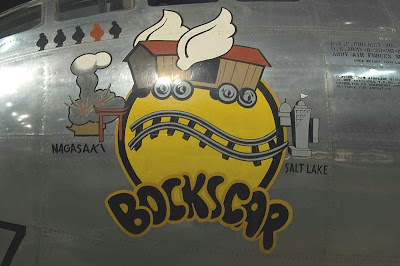Boing
B-29 “Bockscar”
El
B-29-36-MO 44-27297 fue construído
Glenn L. Martin Aircraft Plant en Omaha y fue uno de los 10 aparatos
modificados con el baño de plata (silverplate). El bombardero fue
entregado a la USAAF el 19 de marzo de 1945 y asignado al Capitán Frederick C. Bock y la tripulación C-13
trasladándose a Wendover Army Air Field, Utah.
El
11 de junio abandonó Wendover para alcanzar Tinian el 16 de
junio dónde sería asignado al
393rd Bomb Squadron perteneciente al 509th Composite Group. Este
grupo tenía en plantilla un total de 15 silverplate B-29 en su base en
Tinian. Inicialmente recibió el número de victoria 7 pero el 1 de agosto lo
cambió por la N dentro de un triángulo pintado en su deriva (444th Bomb Group)
como medida de seguridad cambiando su número de victoria por un 77 para evitar
errores de identificación con los aparatos del 444th Bomb Group.
Bockscar solo fue usado en 13 misiones de
entrenamiento desde Tinian y 3 misiones de combate bombardeando objetivos
industriales japoneses, Niihama y Musashino. Al mando del 1st Lt. Don Albury y
la tripulación C-15, atacaron Toyoma.
En noviembre de 1945 regresó a los Estados
Unidos siendo asignado al 509º BG en Roswell Army Air Field, Nuevo Méjico. Fue asignado nominalmente para la Operación Crossroads,
pero no hay registros que indquen que
se desplegó para las pruebas. En agosto de 1946 se le asignó a la Unidad Base 4105a en
Davis-Monthan Army Air Field,
Arizona, para su almacenamiento.
En Davis-Monthan fue nombrado como el avión que bombardeo Nagasaki
pero con las marcas de The Great Artiste.
En septiembre de 1946 fue enviado al Mueso de la Fuerza Aérea (ahora
el Museo Nacional de la Fuerza Aérea de Estados Unidos) en Wright-Patterson
Air Force Base, Ohio, sin embargo no voló hasta allí
hasta el 26 de septiembre de 1961 dónde fueron restauradas sus marcas originales
antes de pasar a ser expuesto.
Fuentes:
ANDERTON,
D. “B-29 Superfortress at War” Shepperton, 1978
BIRDSALL,
S. “Saga of the Superfortress: The Dramatic Story of the B-29 and the
Twentieth Air Force” Sidgewick & Jackson Limited, 1991
PIMLOTT, J.
“'B-29 Superfortress” Bison Books, 1980
National Museum of the United States Air Force
National Museum of the United States Air Force
English version
The B-29-36-MO 44-27297 was
built Glenn L. Martin Aircraft Plant
at Omaha and
was one of the 10 devices modified with silver
plated (silverplate). The
bomber was delivered to the USAAF on 19 March 1945
and assigned to Captain Frederick C. Bock
and crew C-13 moved
to Wendover Army
Air Field, Utah.
The left Wendover on June 11 to reach Tinian on June 16 where it would be assigned to 393rd Bomb Squadron 509th Composite Group belongs to. This group had on staff a total of 15 silverplate B-29 at its base on Tinian. Initially the number of victory was 7 but it changed on August 1 by the N in a triangle painted on its drift (444th Bomb Group) as a measure of security by changing the number of victory by 77 to avoid misidentification with the apparatus the 444th Bomb Group.
Bockscar was only used in 13 training missions from Tinian and 3 combat missions bombing Japanese industrial targets, Niihama and Musashino. Commanded by 1st Lt. Don Albury and crew C-15, attacked Toyoma.
In November 1945 he returned to the United States being assigned to the 509 th
BG at Roswell Army
Air Field, New Mexico. He was assigned to Operation
Crossroads nominally, but no records indquen was
deployed for testing. In August
1946 he was assigned to the 4105th Base Unit
at Davis-Monthan Army Air Field, Arizona, for storage.
At Davis-Monthan was named the Nagasaki bombing plane but with the marks of The Great Artiste. In September 1946 he was sent to Mueso Air Force (now the National Museum of the United States Air Force) at Wright-Patterson Air Force Base, Ohio, but did not fly there until September 26, 1961 where they were restored original brands before becoming exposed.
At Davis-Monthan was named the Nagasaki bombing plane but with the marks of The Great Artiste. In September 1946 he was sent to Mueso Air Force (now the National Museum of the United States Air Force) at Wright-Patterson Air Force Base, Ohio, but did not fly there until September 26, 1961 where they were restored original brands before becoming exposed.
Crew C-15. front row: Dehart, Kuharek, Buckley, Gallagher, Spitzer; back row: Olivi, Beahan, Sweeney, Van Pelt, Albury
Sources:
ANDERTON,
D. “B-29 Superfortress at War” Shepperton, 1978
BIRDSALL,
S. “Saga of the Superfortress: The Dramatic Story of the B-29 and the
Twentieth Air Force” Sidgewick & Jackson Limited, 1991
PIMLOTT, J.
“'B-29 Superfortress” Bison Books, 1980
National Museum of the United States Air Force
National Museum of the United States Air Force





No hay comentarios:
Publicar un comentario